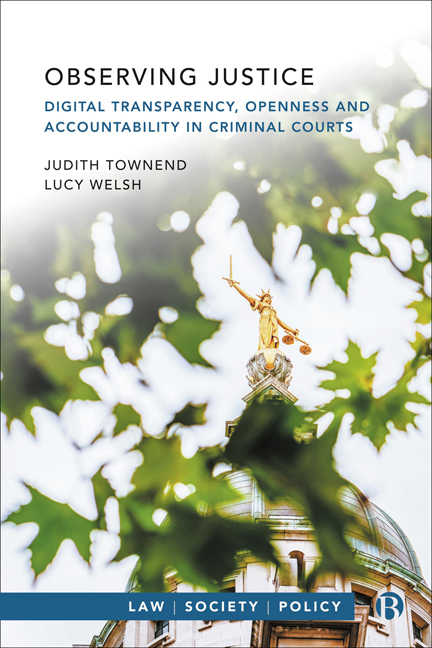Book contents
- Frontmatter
- Contents
- Series Editor’s Preface
- About the Authors
- Acknowledgements
- ONE Introduction: Why We Need to Rethink Approaches to Open Justice in the Criminal Courts
- TWO A History of Accountability in Criminal Courts
- THREE Justice System Modernisation, Digitalisation and Data
- FOUR The Role of the Public and Media in Observing Justice
- FIVE The Human Impact of Justice System Transparency
- SIX Conclusion: Towards a New Framework for Justice System Accountability
- References
- Index
TWO - A History of Accountability in Criminal Courts
Published online by Cambridge University Press: 28 March 2024
- Frontmatter
- Contents
- Series Editor’s Preface
- About the Authors
- Acknowledgements
- ONE Introduction: Why We Need to Rethink Approaches to Open Justice in the Criminal Courts
- TWO A History of Accountability in Criminal Courts
- THREE Justice System Modernisation, Digitalisation and Data
- FOUR The Role of the Public and Media in Observing Justice
- FIVE The Human Impact of Justice System Transparency
- SIX Conclusion: Towards a New Framework for Justice System Accountability
- References
- Index
Summary
Introduction
This chapter provides historical context on the way in which open justice and accountability have developed in England and Wales. It considers modes of accountability in the criminal process, public participation in the criminal courts, and its development in recent decades. We consider the place of open justice in a wider tradition of justice system accountability, sitting alongside and underpinning other important tools, such as inspectorates, complaints mechanisms, rights of appeal, post appeal reviews and judicial review. As part of this exercise, we detail the main methods for contemporary observation of physical criminal court hearings and access to different information types.
We also explore the main theoretical rationales for the contemporary approach to open justice – as articulated variously by practitioners, scholars, and judges – which can be categorised, we suggest, as punitive (shaming), deterring, educational, scrutable (ensuring fairness and proper conduct). The chapter then critiques these various arguments, proposing that understandings of justice system accountability need to recognise the distinction in the rationales, and their weaknesses and strengths. We introduce one of our core arguments, that policy and law makers should prioritise informational transparency as a means of scrutiny and education, rather than as a means of an individual’s punishment and deterrence.
Accountability and access to justice in the criminal process
Although often conflated with the ability of people to access legal representation, access to justice is a broad and multifaceted concept. Emerging in the 1970s as a social right (Cappelletti et al 1976), access to justice has come to encompass issues such as complexity in application procedures (Adams-Prassl and Adams-Prassl 2020), intellectual, practical, emotional, and attitudinal barriers (McKeever et al 2022), and the ability to understand and participate in proceedings (Welsh 2022), in addition to the ability to access specialised legal advice (Cornford 2016). Byrom offers an ‘irreducible minimum standard’ of access to justice ‘composed of the following elements: (i) access to the formal legal system, (ii) access to an effective hearing, (iii) access to a decision in accordance with substantive law, (iv) access to remedy’ (2019, p 4). Emerging from these understandings of access to justice are multiple principles that people may need to invoke to vindicate their legal rights in any circumstance.
- Type
- Chapter
- Information
- Observing JusticeDigital Transparency, Openness and Accountability in Criminal Courts, pp. 12 - 39Publisher: Bristol University PressPrint publication year: 2023

